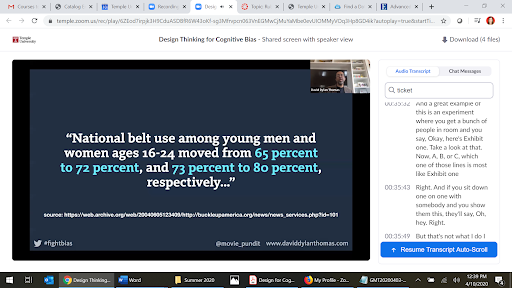Last month, the Innovation and Entrepreneurship Institute (IEI) hosted more than 160 people via Zoom as part of its Innovation Leaders Speaker Series: Design Thinking for Cognitive Bias. The featured speaker was David Dylan Thomas, content strategy advocate at Think Company, a Philadelphia-based design and software development firm. Thomas is also the creator of the Cognitive Bias Podcast.
Kerry Slade, assistant academic director of the IEI, hosted the webinar.
“The process of innovation is just as important as the end result: the product or service that you’re trying to create. The first step in the design thinking process is customer empathy, and empathy is about understanding the minds of your customers: What are they thinking about and how do they think? By the same token, it’s hard to have empathy if you don’t understand the way you think and the way your mind processes information,” Slade says. “David’s insights into cognitive bias relate to the process of innovation–how can we make sure that process is free from bias, is equitable and actually produces the best products and services for the customers that you’re trying to serve.”
Throughout the webinar, Thomas highlighted the ways we can use our brain’s natural tendency to take shortcuts to maximize consumer messages. For example, he demonstrated that “rhyming saves lives” by citing statistics from the “Click it or Ticket” campaign, which increased the percentages of people buckling their seatbelts.

He also demonstrated the bandwagon effect, which causes people to adopt others’ points of view when their own opinion is the outlier.
“So if you’re doing some kind of design exercise, for example, where you have a bunch of people in a room, you have to get their honest opinion, don’t have them just raise their hands. . . . [instead,] write down your answers on stickies [and] you just gather them all up and start to aggregate,” Thomas says. “You’re much more likely to get an honest opinion and people in the room can see, oh, I’m not the only one who thought that wasn’t a great design and they feel more empowered to speak.”
Finally, he emphasized “the most dangerous bias in the world:” the framing effect. How one phrases a question can influence the outcome of a discussion. But framing can be used for good. If questions are open-ended without underlying assumptions, you can stimulate a more hearty discussion about real issues and minimize bias. For example, research shows that female professors and professors of color are rated lower by students than male professors. But when students are alerted to this fact before they filled out the evaluation, their ratings are higher for women and people of color than people who did not receive that framing message.
View the webinar here, and learn more about Thomas here.
To learn more about the Innovation Management & Entrepreneurship Masters Degree, click here. IEI also offers three-course certificates in Innovation Strategy, Healthcare Innovation Management, and Entrepreneurship & Technology Commercialization. All of the programs are available both in-person and online.
IEI will host two upcoming webinars, Innovation Intelligence: Anticipating the Future in Turbulent Times on May 14, and The State of the Entrepreneurial Ecosystem on June 12.

